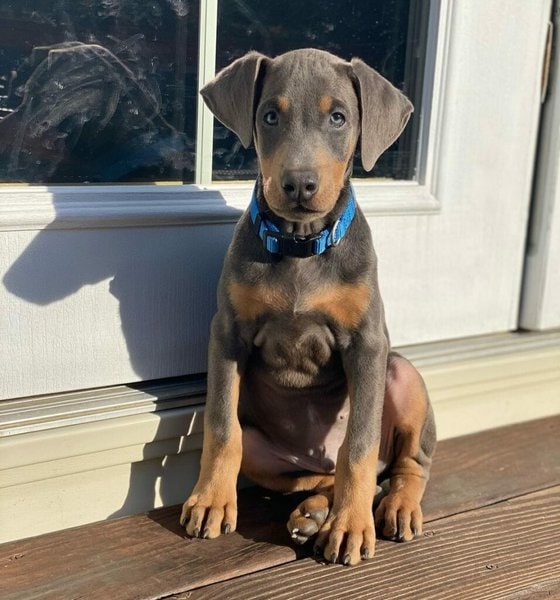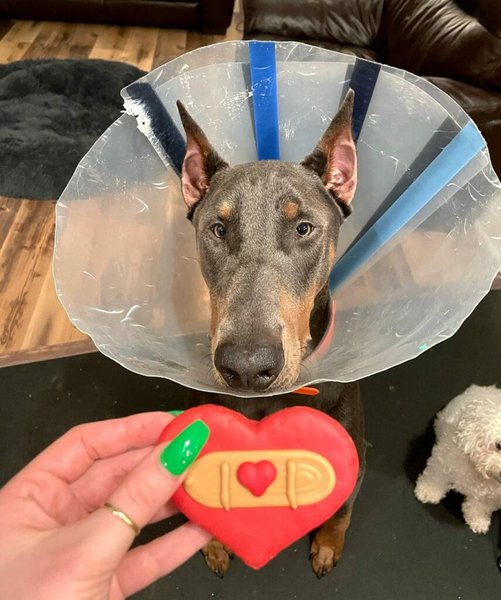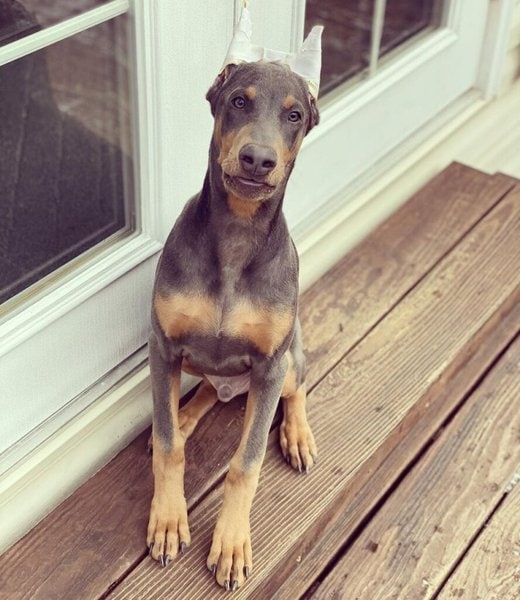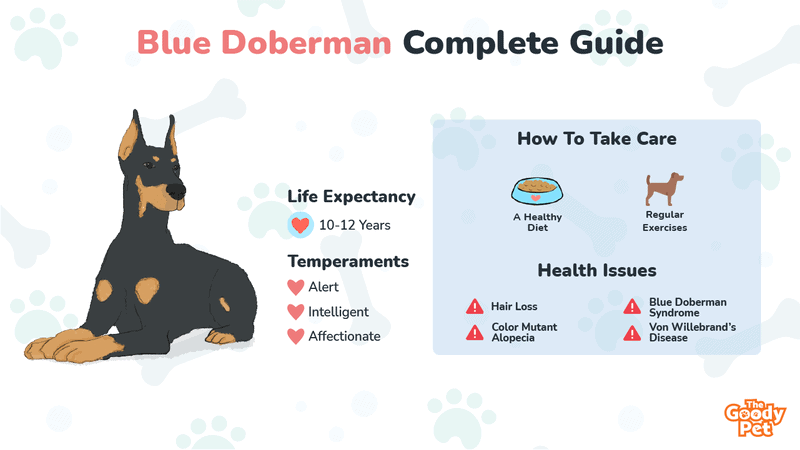Did you know that the Doberman is a mixture of multiple breeds and not simply a conventional designer dog? Originated from Germany, Doberman Pinschers were initially bred by a tax collector named Herr Karl Louis Dobermann in 1890. Mr Dobermann was not just a tax collector, but he had several jobs which required him to commute with bags of cash at night, of which can be dangerous when done alone. His solution to his predicament was to breed a dog that would be able to keep him safe while he went about his business. Despite having the breed to be named after him, Mr Dobermann failed to adequately record his breeding process.
So, nobody knows the exact breed combination involved in breeding the Doberman. But what’s known about the Blue Doberman is that its blue color variant is due to the presence of the dilution gene coupling with the black color gene.
The Blue Doberman is truly a fascinating breed and we have only scratched the surface of what makes this breed so intriguing. We will be discussing its lifespan, temperaments, and other things that you ought to know about. However, let us first understand how rare the Blue Doberman is.
Are Blue Dobermans Rare?
Yes, Blue Dobermans are rare. This is because of blue being a rare color variant within the purebred Doberman breed. Blue Dobermans only make up 8 to 9% of the Doberman breed, but it is not regarded to be the rarest color variant of the Doberman breed (well, fawn colored Doberman is).
Appearance
The Blue Dobie has a sleek and elegant appearance. Blue Dobies are muscular and have a noticeably athletic form. They have ears that stand at attention and wedge-shaped heads.
Blue Dobies have short and sleek fur coats. Their fur coats tend to have a beautiful glistening dark hue.
The blue color variation of the Blue Dobie is the result of the combination of two genes – black and color dilution genes. The black color gene is diluted by the dilution gene, which results in the blue color variation.
Size
According to the American Kennel Club, a male Blue Dobie would typically weigh 75 to 100 lbs and be 26 to 28 inches tall. While a female Blue Dobie would typically grow to weigh 60 to 90 lbs and reach a height ranging between 24 to 26 inches.

How Long Do Blue Dobermans Live?
You can expect your Blue Dobie to live up between 10 to 12 years.
Blue Dobies are prone to several health issues, some of which are specific to their color variation and others that generally affect the Doberman breed. Such health issues include:
Blue Doberman Syndrome
Blue Doberman Syndrome, also called Blue Balding Syndrome, is a hereditary skin condition that affects Blue Dobies. This condition affects dogs with diluted fur coats.
Such a syndrome produces a structural defect, resulting in an irregular distribution of melatonin in the hair shafts of Blue Dobies. Blue Dobies who are affected by this condition often develop baldness over the diluted areas.
If your Blue Dobie starts to develop unusual hair loss, we suggest consulting your veterinarian as soon as you can to ensure early detection of this condition. The hair loss experienced because of Blue Doberman Syndrome is often permanent.
However, should your Blue Dobie develop secondary infections on their skin, they can be treated with antibiotics.
Color Mutant Alopecia
Color Mutant Alopecia is a condition that affects Blue Dobies’ fur coats. Dogs who are affected by this condition are often born with normal fur coats and this condition gradually begins to manifest at the age of 4 months.
This condition is caused by a genetic defect, and it disrupts the manner in which pigments are distributed in your Blue Dobie’s hair shafts. Your Blue Dobie’s fur will become brittle, and they can also develop hair loss in the affected areas.
Color Mutant Alopecia cannot be cured, and secondary skin infections can occur as a result of this condition. However, treatment can be implemented to counter secondary infections.
Von Willebrand’s Disease
Von Willebrand’s Disease is a hereditary blood disorder that affects the blood’s clotting ability. The most noticeable symptom of Von Willebrand’s Disease is excessive bleeding after incurring an injury or undergoing surgery.
Unfortunately, Von Willebrand’s Disease cannot be cured. The only means of remedy is a blood transfusion with another dog. If your Blue Dobie has this condition, they can live a normal life, but you should not breed dogs experiencing such a condition because it is hereditary.

How To Take Care Of Blue Dobermans?
Physical Activity
Blue Dobermans are a highly energetic breed that require a lot of exercise, lasting about 2 hours for every session on a daily basis.
You should take your Blue Dobie on leashed walks, playtime in the yard, or other sorts of physical activity such as hikes.
Remember that when you get a dog, you should get a dog that fits into your family’s lifestyle. If your family does not particularly enjoy physical activities or simply does not have the time for it, a Blue Dobie would not be the dog for you.
Blue Dobies should ideally be kept in country homes, or any home with enough space for them to roam and play around. Their homes need to be fenced, to your Blue Dobie’s safety, as well as the safety of those who may pass your home.
Dietary Needs
Blue Dobermans are active dogs, so they require more calories than most dogs. You should feed your Blue Dobie 2.5 to 3.5 cups of dry food, which should be divided into two meals, every day. If your Blue Dobie is a puppy, you should feed them ½ cup of dog food, three times every day.
You should care for your Blue Dobie’s physique and gut health by paying close attention to not only the amount of food that they eat but also the quality of their meals.
Pet Plate offers dog food that supplies dogs with nutrients that keep them healthy. Not only are the meals provided freshly made and healthy, but they are also delicious, so your Blue Dobie would enjoy and love those meals.
Nutritional Supplements
Although most of your Blue Dobie’s Nutritional needs are satisfied by good-quality meals, they still need an extra boost. You can give your Blue Dobie this extra nutritional boost by introducing supplements to their diet.
Fish oils contain omega-3 fatty acids that support your dog’s immune system. As such oils also help to maintain the health of a dog’s skin and fur coat, fish oils are especially important for Blue Dobies because they are prone to skin and fur disorders.

Are Blue Doberman Good With Kids? Temperaments Of Blue Dobermans
Every Blue Doberman has a different personality, some may enjoy being around kids, while others may not. However, Blue Dobies are generally excellent with kids if they are raised around them.
Intelligent
Blue Dobies are intelligent and curious based on Stanley Coren’s ranking list. They are also playful and loyal. They are natural protectors that bond to their owners with ease and with proper training and early socialization, they can be amazing family dogs who would not hesitate to protect any member of their family.
Alert
Blue Dobies are alert and have a slightly aggressive nature. When you expose your Blue Dobie to early socialization, it counters their aggressive nature and makes them a lot more friendly. You should try socializing your puppy with different people and dogs.
Affectionate
Blue Dobermans are affectionate dogs who enjoy feeling needed and loved by their owners. They enjoy being close and having a snuggle with their beloved owners.
Do Blue Dobermans Shed A Lot? Grooming Tips For Blue Dobermans
Blue Dobermans do not shed a lot, they can be considered to be moderate shedders. The volume of shedding experienced by Blue Dobies is consistent throughout the year.
Blue Dobies have a single coat of fur which makes them relatively easy to groom. Here are some helpful grooming tips for your Blue Dobie:
Brushing
You should brush your Blue Dobie’s fur coat once a week. When you brush your Blue Dobie, we suggest doing so outside because they will shed while you brush them.
For more convenience when trying to remove your Blue Dobie’s loose fur, we suggest using the Furminator Undercoat Tool. This tool will help you remove your dog’s loose fur and reach the root of your dog’s fur without hurting them.
Bathing
Bath your Blue Dobie only when you need to, which could be every 6 to 8 weeks. Your dog’s fur contains essential oils and when you over-bath them, you would be depriving them of those essential oils.
Over-bathing results in your Blue Dobie’s fur becoming dry and brittle. You should pay close attention to the number of times you bathe your dog, especially if they have a skin/fur condition.
To maintain the health and glister of your Blue Dobie’s fur coat, we suggest using a gentle and nourishing shampoo and conditioner, such as the Mighty Petz 2-In-1 Dog Oatmeal Shampoo and Conditioner.
Cleaning Ears, Nails And Teeth
You should check your Blue Dobie’s ears, nails, and teeth regularly to avoid build-up and potential infections and diseases.
Nails should be trimmed as often as necessary and teeth should be brushed 2 to 3 times each week. Your Blue Dobie’s ears should be cleaned at least once every month.
Related Questions
How Much Are Blue Dobermans Worth? Blue Doberman puppies are worth between $1,500 to $2,500 when bought from a reputable breeder. Blue Dobies would typically cost more or less the same as Black Dobies and Red Dobies.
Can Blue Dobermans Swim? Yes, Dobermans can swim. They are naturally strong swimmers, and they can easily adjust to being in the water. However, you should not force your Dobie into water. Dobies do not respond well to coercion as they may, in turn, display some form of aggression. Your Dobie will enjoy their swim a lot more if they naturally make their way into the water.
Do Blue Dobermans Have Blue Eyes? Yes, some blue Dobermans can have blue eyes. However, it is not guaranteed that your newborn Dobie will have blue eyes, Dobies can develop a range of different colored eyes. Blue Doobies commonly have dark brown or hazel eyes.





